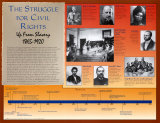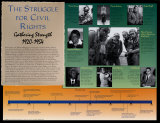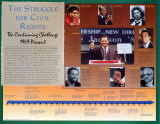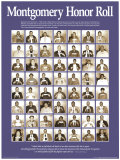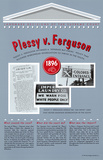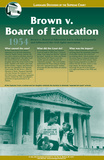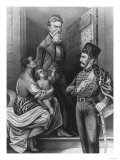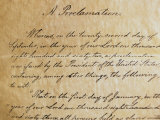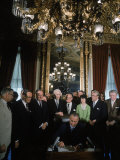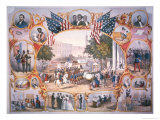|
|
|
|
|
|
|
BLACK HISTORY ECARDS
|
|
|
|
|
|
|
|
|
|
|
| BOOKS ABOUT THE CIVIL RIGHTS MOVEMENT |
|
|
|
|
|
|
|
|
|
|
|
|
|
|
|
|
|
|
 |
|
|
|
|
|
|
|
The Struggle for Civil Rights Black History Poster Series
for social studies classrooms, home schoolers and motivational and inspirational theme decor.
|
social studies > history > Black History > CIVIL RIGHTS < Bill of Rights
|
|
Civil Rights History covering 1865-1890, 1920-1954, and 1968-Present.
Civil rights are the rights of citizenship - see quotes on Civil Rights.
|
|
The Struggle for Civil Rights 1865 - 1920 Poster
The end of the Civil War brought freedom and hope to former slaves throughout the South. No longer would they live in chains and in fear of their master's whips. But for far too many former slaves this joy did not last long. The chains and whips were soon replaced by less noticable but equally demeaning forms of oppression. Most blacks continued to work in the fields of white landowners. Slave codes which had kept slaves from moving about freely and from receiving an education, were replaced by equally harsh “black codes”. But in their daily lives, blacks made communities and worked to make their lives better. For a time, the federal government helped – by setting up thousands of all-black schools and by protecting the right of blacks to vote. This helped a number of black men win elections to state legislatures and to Congress. But this taste of power was short lived. After the 1870s the federal government in the South much less protection. Soon, governments in the South put in place special voting restriction and harsh new forms of segretation – or “Jim Crow” laws. Lynching and other forms of terror became all too common in the South. Around the time of World War I, new opportunities led many blacks to look to the North as the place where their dreams might be fulfilled. And a few, such as began to organize blacks for a long struggle against racial prejudice and discrimination.
Individuals on poster - Booker T. Washington, W.E.B. Du Bois, Ida B. Wells, George Washington Carver at Tuskegee Institute, Scott Joplin, Granville Woods, Robert Smalls, Early African American members of Congress - Senator Hiram R. Revels and Representatives Benjamin S. Turner, Josiah T. Walls, Joseph H. Rainey, Robert Brown Elliot, Robert D. De Large, and Jefferson H. Long.
|
|
|
|
Civil Rights 1920 - 1954 Poster
For Blacks, the “Great Migration” North began during World War I and picked up steam in the 1920s. In the North, however, a great many blacks met with continued disappointment and despair. In the northern cities, a growing number of blacks had to compete with whites for jobs. Discrimination, it turned out, was a much a part of life in the North as it was in the South. Blacks spoke of being the “last hired and first fired.” Yet for some, the move to the North was liberating. An incredible flowering of literary and musical achievement known as the Harlem Renaissance took place in New York City's famous black distict. African American leaders emerged, pushing for integration, as the NAACP did, or expressing a new spirit of separation, as in Marcus Garvey's “Back to Africa” movement. But conditions for most blacks, North and South, worsened during the Great Depression. It wasn't until World War II that a new sense of opportunity set in. Almost one million blacks served in the armed forces in the war – many with distinction. Hence black leaders voiced disgust at the diescrimination returning black veterans continued to face. Organization such as the NAACP and CORE, bolstered by growing support from both black and whites, mounted ever stronger battles in the courts against discrimination, and several marches and sit-ins foreshadowed the events to come as the civil rights movement began to come of age.
Individuals on poster - Marian Anderson, Mary McLeod Bethune, Marcus Garvey, Thurgood Marshall, A. Philip Randolph, Jackie Robinson, Tuskeegee Airmen, Ralph Bunche.
|
|
|
|
The Struggle for Civil Rights, The Continuing Challenge - 1968 - Present Poster
The battle to end legal segregatin in America, which the Rev. King and others fought so hard for, had mostly been won by the end of the 1960s. Voting restritions were abolished in the mid-1960s. Black leaders then began to concentrate on getting more and more African-Americans registered to vote, And beginning in the late 1960s and early '70s an ever-increasing number of blacks did begin to win election to positions of power in government. By the 1980s, many of American's largest cities were being led by black mayors. In 1984, it seemed that the civil rights movement had finally “arrived” with the presidential campaign of the Reverend Jesse Jackson, once a close aide to the Rev. King. His strong showings in both the 1984 and 1988 primary elections proved that millions of Americans, both black and white, were now ready to take an an African-American candidate for President seriously. Still, big problems continue to challenge African-Americans. Family breakdown, drugs and crime, a lack of jobs, and continuing racial prejudices created a mood of deep despair, among many blacks left behind in the nation's run-down inner cities. Nevertheless, more and more African-Americans today are going to school and getting an education. And blacks in business, the arts, politics, entertainment, the universities and elsewhere are succeeding – and helping to change the nation – as never before. The long struggle for racial justice is not over. But it has made huge strides in improving the lives of African-Americans and in overcoming the nation's tragic legacy of racial strife and injustice.
Individuals on poster - Jesse Jackson, Barbara Jordan, Tom Bradley, Toni Morrison, Andrew Young, Roy Innis, Marian Wright Edelman, Benjamin Hooks.
|
|
|
|
The Montgomery Bus Boycott was a political and social protest campaign against the policy of racial segregation on the public transit system of Montgomery, Alabama.
The boycott began December 1, 1955 when Rosa Parks, an African American woman, was arrested for refusing to surrender her seat to a white person and ended December 20, 1956, when a federal ruling, Browder v. Gayle, took effect, and led to a United States Supreme Court decision that declared the Alabama and Montgomery laws requiring segregated buses to be unconstitutional.
Important figures in the boycott include Reverend Martin Luther King, Jr. and Ralph Abernathy.
FYI ~ Future baseball star athlete Jackie Robinson, as a member of the United States Army, was brought before a court-martial in 1944 when he refused an order to move to the back of the bus. He was acquited.
In March of 1955, Claudette Covlin, a 15-year-old student at Booker T. Washington HS in Montgomery and a member of the NAACP Youth Council, was arrested and removed from a bus when she refused to give up her seat to a white man. Rosa Parks was an advisor to the youth group.
|
|
|
|
Plessy v Ferguson
5-18-1896, affirmed a 'separate but equal' policy that allowed widespread segregation to thrive in the South. Pless v Ferguson upheld the "Jim Crow" laws that helped maintain segregation in the South.
What caused the case? The case of Plessy v. Ferguson arose when Homer Plessy, a black man, objected to a Louisiana state law requiring separate railroad cars for black and whites. Mr. Plessy was arrested when he refused a condutor's order to sit in the car for black passengers. In a trial, Mr. Plessy was found guilty of breaking the law. In response, he sued the judge in the case, a man named John Ferguson. His suit claimed that the Louisiana law went against the Constitution's 14th Amendment, which guarantees to all citizens the equal protection of the laws.
What did the court do? - The Supreme Court reviewed Mr. Plessy's claim that the Louisiana law violated the 14th Amendment's equal protection guarantee. But the Court upheld the law. It agreed that the 14th Amendment did guarantee all citizens equal protection. However, it said that separate facilities did not take away this protection – as long as the facilities were truly equal. Moreover, it denied that such “separate but equal” facilities would necessarily make black feel inferior to whites.
What was the impact? In Plessy v. Ferguson, the court said it would allow “separate but equal” public facilities for blacks and whites. And in the years that followed, many states did set up racially separate public facilities. But these facilities were seldom equal. In fact, accommodations for whites were almost always superior to those for blacks. In effect, the ruling made it easier for widespread segregation to exist throughout the South and elsewhere for more than 50 years.
• more Landmark Decision of the Supreme Court posters
|
|
|
|
Brown v Board of Education Topeka, Kansas Wall Poster
5-17-1954 - “Separate educational facilities are inherently unequal.”
What caused the case? In 1951, Karen Brown was denied admission to an all-white elementary school in Topeka, Kansas. Instead, she was told to attend an all-black school in another neighborhood. Her father sued the school district for not letting his daughter attend the school closest to her home. Together with similar cases from South Carolina, Virginia an Delaware, the case was appealed to the Supreme Court under the title, Brown v. Board of Education of Topeka. Thurgood Marshall, who later became the Supreme Court's first black Justice, argued fhat segregated schools violated the 14th Amendment's guarantee of equal protection to all citizens.
What did the court do? - In an unanimous decision, the Supreme Court set aside its 1896 Plessy v. Ferguson ruling. That ruling had allowed "separate but equal" facilities for whites and blacks. Chief Justice Earl Warren wrote that racially separate public schools are always wrong – no matter how “equal” in quality. The Court further undermined the Plessy ruling by finding that such “separate but equal” facilities do encourage the idea that blacks are inferior to whites.
What was the impact? Brown v. Board of Education of Topeka did not bring about the immediate integration of all public schools. But it did have far-reaching effects. School systems across the nation began to integrate blacks into what had been all-white schools. Many began busing programs in an effort to balance the mix of races. And to a very large degree, the decision helped encourage the growth of the historic civil rights movement of the 1950s and 1960s.
|
|
|
|
John Brown
b. 5-9-1800; Torrington, CT
d. 12-2-1859; Charles Town, VA - executed by hanging
The abolitionist John Brown “advocated and practiced armed insurrection” as a means of abolishing all slavery. He was active in “Bleeding Kansas” in 1856 and the 1859 raid on an arsenal at Harper's Ferry.
He wrote, on the day of his death; “I, John Brown, am now quite certain that the crimes of this guilty land will never be purged away but with blood. I had, as I now think, vainly flattered myself that without very much bloodshed it might be done.”
FYI - One of the men killed in the raid was Lewis Sheridan Leary, who was the first husband of poet Langston Hughes grandmother.
• Fiery Vision: The Life and Death of John Brown
|
|
|
|
The Emancipation Proclamation
“I do order and declare that all persons held as slaves within designated States, and parts of States, are, and henceforward shall be free.”
In the middle of the Civil War, President Abraham Lincoln signed the Emancipation Proclamation, declaring that all the slaves in the territories that were fighting against the Union “are, and henceforward shall be free.” With this document, President Lincoln made it clear that the purpose of the Civil War was not only to preserve the Union, it was also to free the slaves.
Although Lincoln had always opposed slavery, the Civil War was not, in the beginning a fight to end it. Southern states had seceded, or separated, from the United States because they were worried that the U. S. governemnt would try to limit slavery. Lincoln's primary goal was to hold the country together. He worried that if he tried to end slavery, slave states such as Kentucky and Missouri, which bordered the South but remained part of the Union, would join the Confederacy. But eventually, Lincoln realized that the United States could not survive if some of its people were not free. In addition, he needed to gain the support of countries such as France and England. These countries relied on the South to supply them with cotton, but they were also very opposed to slavery, if the Union's aim was to free the slaves, they would side with the North.
On January 1, 1864, Lincoln issued the Emancipation Proclamation. In it, he said freeing the slaves was 'an act of justice.' But though the proclamation sent an important message against slavery, it did not free a single slave on the day it was signed. The proclamation only freed slaves in the states that were not under the control of the Union. Slaves in the loyal border states were not freed, and Lincoln had no authority to free the slaves in areas controlled by the Confederacy. But as the Union army advanced and took control of new Confederate territories, slaves were freed. The proclamation also welcomed African Americans into the Union's armed forces. By the end of the war nearly 200,000 former slaves and free black had fought for the Union.
Abraham Lincoln later said that the Emancipation Proclamation was “the central act of my administration, and the greatest event of the 19th century.” Although it was mostly symbolic on the day it was signed, the proclamation sent a message that the United States was a free nation where slavery would not be tolerated. Henry Ward Beecher, a leading abolitionist, affirmed “The Proclamation may not free a single slave, but it gives Liberty a moral recognition.” The work that began with the Emancipation Proclamation was completed on December 18, 1863, with the ratification of the 13th Amendment to the Constitution, banning slavery in the United States.
|
|
|
|
Scottsboro
In 1931 nine black youths were charged with raping two young white women on a freight train in Alabama. Eight of the defendants were sentenced to death after the first trial in Scottsboro, Alabama. In the next decade there would be seven retrials and two landmark Supreme Court decisions. A political deal was struck in the final trial, 1937-38, in which four defendants (later pardoned) got life imprisonment, and the charges against the others dropped. The case embroiled the nation for many years and still has resonance. The Communist Party quickly entered the defense and was often at odds with conservative black defenders. (book description)
The writer Muriel Rukeyser reported on the Scottsboro case.
|
|
|
|
The National Voting Rights Act of 1965 outlawed discriminatory voting practices that had been responsible for the widespread disenfranchisement of African Americans in the United States.
Echoing the language of the 15th Amendment, the Act prohibited states from imposing any “voting qualification or prerequisite to voting, or standard, practice, or procedure ... to deny or abridge the right of any citizen of the United States to vote on account of race or color.”
• 13th Amendment officially abolished and continues to prohibit slavery and involuntary servitude, except as punishment for a crime. 1868
• 14th Amendment granted citizenship to all people “born or naturalized in the United States,” and included the due process and equal protection clauses. 1868
• 19th Amendment prohibits each of the states and the federal government from denying any citizen the right to vote because of that citizen's gender. August 18, 1920. Women Activist posters.
|
|
|
|
| The following 2 posters of the set are no longer available commercially; perhaps you could have students create their own versions... |
 |
Civil Rights 1790 - 1865 Poster
|
|
 |
Civil Rights - 1954 - 1968 Poster
|
|
previous page | top
|
|
I have searched the web for visual, text, and manipulative curriculum support materials - teaching posters, art prints, maps, charts, calendars, books and educational toys featuring famous people, places and events - to help teachers optimize their valuable time and budget.
Browsing the subject areas at NetPosterWorks.com is a learning experience where educators can plan context rich environments while comparing prices, special discounts, framing options and shipping from educational resources.
Thank you for starting your search for inspirational, motivational, and educational posters and learning materials at NetPosterWorks.com. If you need help please contact us.
|
|
|












